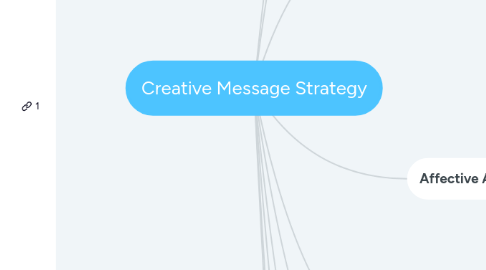
1. References O'Guinn, T. C., Allen, C. T., Scheinbaum, A. C., & Semenik, R. J. (2019). Creative Message Strategy. In Advertising and integrated brand promotion (6th ed.). Barnum, P. T. (2010, October 14). Message Strategy. Retrieved from Message Strategy Brnad Post. (2015, May 18). How To Define Your Brand Personality | FINIEN. Retrieved from http://www.finien.com/2015/06/how-to-define-your-brand-personality/# BusinessDictionary. (n.d.). What is brand recall? Retrieved from http://www.businessdictionary.com/definition/brand-recall.html Diaz, D. (2015, December 17). Scared Into Action. Retrieved from https://allembracingadvertising.wordpress.com/2015/10/31/scared-into-action/ MANAGEMENT STUDY GUIDE. (n.d.). Brand Image - Meaning and Concept of Brand Image. Retrieved from https://www.managementstudyguide.com/brand-image.htm Marketing Schools.org. (n.d.). Persuasion Marketing | What is Persuasion Marketing? Retrieved from http://www.marketing-schools.org/types-of-marketing/persuasion-marketing.html Merca 2.0. (2016, September 6). ¿Qué es un slice of life advertisement? Retrieved from https://www.merca20.com/260363-2/ The Scholarly Commons. (2005). Transforming Consumer Experience: When Timing Matters. Retrieved from https://scholarship.sha.cornell.edu/cgi/viewcontent.cgi?referer=https://www.google.com.mx/&httpsredir=1&article=1318&context=articles
2. Ana Teresa Alcorta Castro 362266
3. Promote Brand Recall
3.1. According to Business Dictionary is a qualitative measure of how well a brand name is connected with a product type or class of products by consumers.
3.1.1. Promoting a brands means using repetition of the brand name as maany times as possible to make consumers remember you.
3.1.1.1. Repetition ads
3.1.1.2. Slogan and Jingle Ads
3.1.1.2.1. Extremely resistant to forgetting.
3.1.1.3. Point of Purchase Branding
3.1.1.3.1. Creates resistance
4. Link Key Attributes to the Brand Name
4.1. A brand’s personality is derived from keywords that best describe your brand’s character as if your brand was a person. You think about how your brand wants to be perceived by your target audience
4.1.1. Unique Selling Proposition (USP) Ads
4.1.1.1. Emphasizes a unique quality of the brand
4.1.1.2. Lasts long time.
4.1.1.3. Very resistant to competitive challenge.
5. Persuade the Consumer
5.1. So much of communication and decision-making occurs at the subconscious level, requiring marketers to consider the psychological underpinnings of purchasing behavior. By understanding the factors that apply at this level, they can be far more effective at persuading people to choose what they want them to choose (and buy).
5.1.1. Reason-why Ads
5.1.1.1. Explaining the consumer they should buy your brand.
5.1.2. Hard-sell Ads
5.1.2.1. Specifies urgency
5.1.3. Comparison Ads
5.1.3.1. Gives audience a change to compare their life without product or service or with other brands
5.1.4. Testimonial Ads
5.1.4.1. People that have tested the brand speaks to audience that haven't and convince them.
5.1.5. Demonstration Ads
5.1.5.1. Opportunity to the audience to experience the benefits
5.1.6. Infomercials
5.1.6.1. Giving all the information the audience needs to convince them.
6. Affective Association
6.1. If a brand is able to trigger its consumers’ emotions well, be it joy, wariness, anxiety, or sadness, the brand has done a success promoting itself.
6.1.1. Feel Good Ads
6.1.1.1. Eager creatives.
6.1.1.2. Better performance in cluttered media environment.
6.1.1.3. May generate competing connections
6.1.2. Humor Ads
6.1.2.1. Create in the receiver a pleasant and memorable association with the brand.
6.1.3. Sex-appeal Ads
6.1.3.1. Gets attention and links degree of sexual arousal and positive feelings to the brand.
7. Scare the Consumer Into Action
7.1. A messaging strategy that wants the consumer to act quickly by stimulating the feelings of fear within people.
7.1.1. Must have a plausible threat to motivate consumers.
7.1.2. Clear and easy to discern link between the threat and the use of advertised brand.
7.1.2.1. Fear-appeal ads
7.1.3. Focus on having a big impact.
8. Change Behavior by Inducing Anxiety
8.1. Often people will buy or consume things to help them in their continuing struggle with anxiety. They will try to find a way to free themselves from it.
8.1.1. Anxiety Ads
8.1.2. Social Anxiety Ads
9. Define the Brand Image
9.1. Brand image is the current view of the customers about a brand. It can be defined as a unique bundle of associations within the minds of target customers. It signifies what the brand presently stands for. It is a set of beliefs held about a specific brand.
9.1.1. Image Ads
9.1.1.1. Iconic potential
9.1.1.2. Very common in some catgories
9.1.1.3. Generally fewer counterarguments generated by consumers.
9.1.1.4. For creatives
9.1.1.5. Can be quickly rejected
10. Give the Brand Desired Social Meaning
10.1. The point is to hape meaninf of branded goods beyond their everyday function, searching for the right social setting.
10.1.1. Slice-of-life Ads
10.1.1.1. The point is to generate empathy with the consumer trough promotion of the brand, using testimonials.
10.1.2. Branded Entertainment: Product Placement, Web Films
11. Resolve Social Disruption and Cultural Contradictions
11.1. Let people see that the brand it's resolving contradictions and cultural problems with their products, services or cause.
11.1.1. Tie the brand to social/cultural movements
12. Transform Consumption Experiences
12.1. Rendering it different than it might have been with-out the advertising information by giving positive memories of the brand during it's consumption.
12.1.1. Transformational ads
12.1.1.1. It can actually make the consumer experience better by creating a brand feeling, expectation or mood that activates when using the product or receiving the service.
